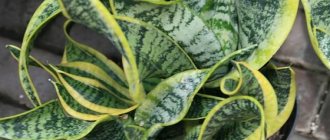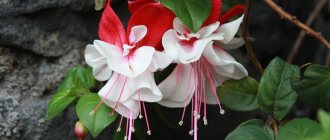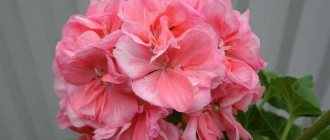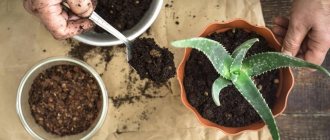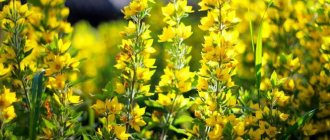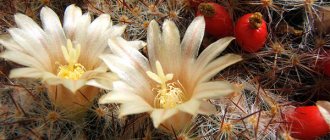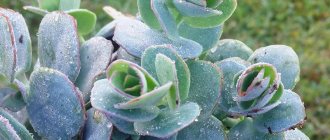What types are there?
Euphorbia is a numerous genus of plants in the Euphorbiaceae family . There are a huge number of species, among which there are both annual and perennial. This genus also includes representatives of different groups:
- succulents;
- herbs;
- shrubs;
- trees.
Moreover, they can be deciduous, leafless, prickly, or have different stems that are different from each other. The only thing that unites representatives of the Euphorbia genus is the presence of white juice, reminiscent of milk.
The sap of any type of milkweed is poisonous, so it is not a suitable plant for apartments with pets and children. You should also be careful when using folk recipes with milkweed: it can only be used externally.
Description of varieties
Indoor spurge has many different species, different from each other . Most often, several of them are grown at home.
Triangular
One of the tallest types of indoor milkweed - it can reach 1 m in height, however, it is most often grown on window sills. A young plant has one trunk, but the older it is, the more branches it has. It has double spines on the tubercles and flattened leaves on thin branches, which is why it looks somewhat strange.
Video about milkweed triangular:
Poinsettia
Also called Euphorbia Beautiful . It is a tall branched bush with many thin stems. The leaves are large (up to 16 cm), oval, but pointed at the ends. Their surface is ribbed, rough, with obvious veins. The bracts are large and red, the flowers are also red and resemble ordinary leaves.
Poinsettia is considered one of the most beautiful species of milkweed.
Video about Euphorbia Poinsettia:
mile
He's a brilliant spurge . It is a highly branching succulent with elliptical leaves and many thick conical needles. It can bloom, the flowers are yellow, orange, white, pink, etc.
Video about milkweed Mil:
Belozhilkovy
It has a single trunk, woody closer to the roots. The leaves are oval, but pointed towards the end, growing on fleshy, succulent branches. Arranged in a spiral. Over time, they die and fall off from the bottom up, with the result that over time the plant resembles a small palm tree, since the foliage remains only at the top. The leaves themselves are dark green with white veins, their reverse side is pale. Doesn't bloom.
Video about Euphorbia Belozhilkov:
Enopla
A highly branching succulent that, under favorable conditions, can grow up to 1 m in height. It has long (about 5 cm) spines, red in a young plant and turning gray in old age.
Bloom
Flowering is characterized by the appearance of small inflorescences at the bases of leaf blades. Euphorbia begins to bloom in April. The flowering process extends over the entire period of active development. In the winter season, if there is good lighting, flowers may also appear.
Annual flowering is not available to all types of euphorbia. For example, the flowering of Euphorbia largehorn or Euphorbia Tirukalli is a very rare occurrence in indoor conditions. Euphorbia Mila and Euphorbia beautiful bloom with ease every year.
If it does not bloom, the reasons should be sought in insufficient sunlight or overfeeding the plant with fertilizers.
Blooming milkweed Mila
Flowering milkweed ribbed
White-veined milkweed blooming
Flowering plants occupy a strong place in the hearts and homes of gardeners. Caring for them is not always easy, but if you know the basic rules you can achieve success. We have prepared for you a whole series of useful articles on this topic. Read all about Impatiens, Gerberas, Hydrangea.
Growing conditions
Since there are many varieties of homemade milkweed, care rules may have nuances depending on the specific species . Most representatives of indoor milkweed are succulents or related species, so general recommendations apply specifically to succulent milkweed.
Air temperature and humidity
The optimal temperature for good growth and development is 20-25 degrees (during the dormant period it should be reduced to 14). Even if the room is too warm, drafts should not be allowed. It is better not to place spurge next to windows that are opened for ventilation.
Humidity does not matter for milkweed: it feels equally good at high, medium, and low humidity.
Where does it grow best?
Euphorbia loves light very much and therefore needs long daylight hours and feels good on window sills or other surfaces close to the window.
But if direct sunlight falls on it for a long time, it may get burned, so you should not place it in front of those windows into which the sun shines directly. In these cases, the plant should be shaded.
In winter, it needs artificial lighting even during hibernation . With a lack of light, at best it stops growing, at worst it withers and dies.
In summer, milkweed can be taken out onto the balcony or into the garden, but in this case you need to monitor precipitation and wind: this plant does not tolerate either of these. At the same time, in calm weather it feels good outside.
Soil requirements
Euphorbia is grown in well-drained soil in full sun. Some species can grow in light shade during the day. Grown as an ornamental plant, almond milkweed (Euphorbia amygdaloides) grows in semi-shady areas.
Some species, such as Euphorbia palustri, prefer a fairly moist substrate, but most prefer dry or moderately moist, well-drained soil. M. Griffith is more demanding, requiring humus, moist, acidic soil.
These extremely tolerant plants grow well in most soil types, including dry, sandy soils. Only loamy soils are not suitable for all species. The ideal soil reaction should be slightly acidic, possibly neutral.
For milkweed in pots, it is better to purchase a special mixture of substrate for cacti and succulents.
When buying milkweed, it is better to learn about the needs of a particular species. The closer we select a planting site according to the conditions that are natural for a particular species, the better the plant will grow.
Home care
How to water?
Different types of milkweed require different watering regimes . Succulents need little water; a small amount of water is enough for them. You can simply moisten the soil every time it dries out. If you forget to water the spurge succulent, it will not get any worse; only systematic breaks are critical. But the less the plant looks like a succulent, the more water it needs.
Dry soil cannot be left, but moistening it or filling it with reserve depends on the type. Like other houseplants, the frequency and amount of watering should be reduced during the dormant period.
Does not require spraying and is indifferent to air humidity levels.
Trimming
After flowering, you need to cut off the bracts, you can also cut off the tops . At the same time, it is better not to touch the largest and healthiest stems, otherwise they will not bloom next year. Dry shoots and leaves should always be cut or broken off, regardless of the season.
Feeding and fertilizer
It does not require additional feeding; moreover, excess mineral fertilizers can be harmful.
Euphorbia can be fed only in small quantities during the flowering period. You can use complex fertilizers for deciduous plants or for succulents, depending on what type of particular spurge is.
In spring, fertilizers are added once a month, in summer - twice a month , always in a minimum dosage.
How to care during the dormant period?
At the end of summer, you need to stop feeding and gradually begin to reduce the frequency and volume of watering. During the dormant period, the optimal temperature for milkweed is about 14 degrees. There is no need to water it abundantly at this time, just lightly moisten the soil.
As spring approaches, the frequency and volume of watering should be increased to prepare the plant for awakening and growth.
Features of transplantation
Euphorbia needs transplants to expand space for roots and renew the soil; it tolerates them well. The older the plant, the less often it needs to be replanted . You need to put drainage in the new pot and sprinkle it with soil. Remove the spurge from the old pot, shake off the soil from the roots as best as possible, get rid of their damaged areas, place them in a new pot and cover them with soil.
Water and place in the shade until rooting, then return to the usual lighted place. Replanting is carried out annually (for old plants once every 3-4 years) in the spring.
Pot
The best option for a pot is deep and not very wide . Holes at the bottom are desirable for sufficient oxygen supply; in this case, the pot should be kept in a tray.
Soil and drainage
The bottom of the pot needs drainage made of pebbles or expanded clay. Soil is poured onto it from a mixture of equal parts of peat, sand, leaf soil and turf. You can buy ready-made soil for succulents (even if this type of milkweed is not one of them).
Trimming
After euphorbia blooms, it is recommended to prune , which will rejuvenate the plant. To do this, you need to trim the elongated shoots and remove the dried stems.
Pruning milkweed to form a crown is done at the end of winter by cutting off shoots. After such pruning, spring flowering will not occur , but the formation of a dense crown of the plant will begin. As a result of this procedure, the next milkweed bloom will be abundant.
What does a flowering plant look like and when does it bloom?
Not all types of milkweed bloom , but in flowering representatives this process occurs almost the same.
The flowers are multi-layered, as if several are nested within one another. If you do not cut off the bracts after flowering, then next year new flowers will appear directly from them, although they will be less developed and inconspicuous.
It blooms annually in late spring or summer ; by early autumn, fruits with seeds are formed, which after ripening must be collected (regardless of whether seeds are needed or not).
Depending on the variety, the flowers come in different colors. Many of the species of milkweed during the flowering period are similar to flowering cacti.
Euphorbia - photo
Just look how spectacular and different milkweed can be! Among such diversity, everyone can find their ideal variety.
Photo: flower.hozvo.ru
Photo: pinterest.com
Photo: sveklon.ru
Photo: 7dach.ru
Photo: lanshaft.com
Photo: zdorovienam.ru
Photo: klubrasteniy.ru
Photo: zelensad.com
Photo: sony-club.ru
Photo: commons.wikimedia.org
Photo: pixabay.com
Photo: marsh-svobody.ru
Photo: pixabay.com
Photo: planteset.com
Photo: tvplaneta.ru
Photo: attuale.ru
Photo: mandarin-shop.ru
Photo: million-wallpapers.ru
Photo: lanshaft.com
Photo: evrookna-mos.ru
Photo: zen.yandex.ru
Photo: zen.yandex.ru
Photo: travtravich.ru
Photo: commons.wikimedia.org
Photo: skolkogramm.ru
Did you like the post? Subscribe to our channel in Yandex.Zen, it really helps us in our development!
Reproduction methods
Cuttings
Cut a shoot 10 cm long and remove the lower leaves. Thoroughly rinse off the juice on the cut with running water and treat the area with charcoal. When the cut dries a little, the shoot should be placed in a pot with wet sand.
Cover the top with a film with several air holes (or a transparent cap), leave until the plant takes root, then transplant into a pot with regular soil. It is important that the sand is always moist and that the sprout is not exposed to sunlight.
Seeds
Most species of milkweed are dioecious . This means that for reproduction you will need two copies: male and female. Euphorbia is not a self-pollinating plant, so you will have to carry out artificial pollination yourself during flowering.
- Mature pollinated seeds need to be collected (usually this happens in the fall) and distributed over a mixture of sand and peat (1:1 ratio), like ordinary garden seedlings.
- Moisten the soil, cover with glass and place in a warm place.
- When the sprouts sprout, the glass can be removed.
- As soon as the first sufficiently developed leaves appear, it is time to plant the seedlings in separate pots with the usual soil for adult plants.
Dividing the root
It is rarely used and not for all species (for example, spurge spurge tolerates this method of propagation well, but some species, especially single-stemmed ones, may die).
- At the end of spring or beginning of autumn, you need to remove the plant from the pot, carefully shake off the soil from the roots, cut off rotten and dry areas.
- Separate the stems along with the roots that belong to them (carefully tear them apart with your hands, and do not cut them), treat the breaks with charcoal.
- Then plant all the bushes in different pots with moist soil and place them in a bright but shaded place until they settle in and recover.
- They can then be moved to bright light.
This method of propagation is undesirable, since spurge does not tolerate it well.
During the first year after division, all the bushes involved in the process will grow poorly and bloom little or not bloom at all.
To help in recovery, you need to care for the plant especially carefully, without skipping watering and fertilizing, making sure there is sufficient lighting for a long time every day.
Why doesn't it bloom?
There are not many reasons why milkweed cannot bloom. Some of the reasons:
- insufficient lighting;
- unsuitable pot size;
- lack of nutrition due to the rapid growth of side shoots.
Solution to the problem:
- moving the flower to a more lit room;
- replanting into a smaller pot;
- pruning side shoots.
Varieties of milkweed differ in appearance from each other. Sometimes it’s even difficult to imagine that both plants belong to the same family. Euphorbia is an unpretentious plant and does not require special treatment or special attention.
Pests and diseases
Euphorbia is most often affected by pests such as:
- spider mite (in this case, a thin cobweb appears on the leaves, they turn yellow and dry out);
- aphids (leaves are covered with a sticky substance, often accumulating in droplets);
- scale insects (appearance of dense scales);
- mealybug (a white coating that looks like cotton wool covered with cobwebs).
In any of these cases, you should completely treat the plant with a soap solution or a store-bought antiparasitic agent and change the top part of the soil. If possible, after the procedure, you can rinse the flower with a shower, but you should try not to flood the soil. Sometimes the procedure needs to be carried out several times.
Also, sometimes milkweed looks unhealthy, which can happen for various reasons:
- Yellowed leaves may indicate the influence of a draft or stagnant moisture. The problem is solved by reducing watering and eliminating drafts.
- Brown spots indicate sunburn. It is necessary to remove the spurge from direct sunlight and shade it. After eliminating the problem, the stains will disappear on their own over time.
- The stems become thinner with a lack of light. You need to move the pot to a place with better lighting.
Characteristics
- Species : depending on the species, it can be a succulent, shrub, bonsai, etc.
- Flower/fruit color : depends on the species (usually blooming white, yellow, pink, red and orange, sometimes other), fruits are different shades of brown.
- Leaf color : different shades of green, sometimes with obvious white veins.
- Sun requirement : high, but does not tolerate direct rays.
- Size : depending on the type - from bushes 10-15 cm to bonsai about 1 m high among indoor species (in the wild there are trees up to 12 m high - like Canary spurge). Creeping species do not exceed 5 cm in height and grow widely to the sides.
- Flowering : some species do not bloom at all, while those that bloom have voluminous flowers, the inflorescences of which seem to be inserted into each other.
- Aroma : none.
Euphorbia is unpretentious, so it is suitable for beginner gardeners. Its poisonous juice poses a danger, so you need to be careful and always wash your hands after working with a flower (pruning, replanting, collecting dry and fallen leaves). The variety of species allows you to choose a plant to suit your taste, which will fit perfectly into the interior of the room.
Cuttings
The perennial is propagated by cuttings or by dividing the mother plant in early or mid-spring in order to have time to separate the planting material from the plant before active growth of milkweed begins. The choice of such a time is not accidental - in this way the possibility of a stressful situation can be eliminated, in the light of which the plant could get sick or die.
Some gardeners prefer to divide perennials in early autumn to give the young crop more time to adapt and take root.
Pros and cons of the method
The advantages include the fact that the method makes it possible to preserve the varietal characteristics of the plant in its “new life”; the disadvantages are the need to take a fairly large fragment, which can adversely affect the appearance of the “donor”.
How to prepare cuttings?
Planting material is taken from the healthiest and most beautiful plant . It is better not to touch young plants, but to take cuttings from an adult perennial.
How to root a shoot?
Cuttings are carried out in several steps.
- A shoot at least five centimeters long is taken from a healthy plant. The cut area on the plant does not need to be treated.
- The cuttings can be rooted immediately or allowed to dry for 1-2 days. Rooting is done immediately in a permanent container, so as not to replant and stress the plant later.
- The soil needs to be well moistened (but do not overdo it, otherwise rotting may occur), after which the plant is covered with film or glass to create a microclimate.
- It is necessary to maintain a constant temperature of at least 20 degrees and sufficient lighting. As a rule, rooting occurs after 2-3 weeks.
